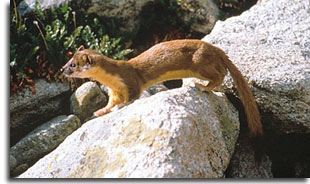Long-Tailed Weasel
(Mustela frenata)
Size & Weight
Body sizes range from 11-17 inches and 5-16 ounces
General Description
Long-tailed weasels are relative small animal, with slender
and elongated bodies.
Males tend to be significantly larger than females.
Overall pelt color is brown with yellowish white neck and underside.
It is the most widely distributed weasel.
Reproduction
Summer is the mating season.
A female reaches maturity in 3-4
month, while males reach maturity in about 1 year.
The female give birth to 4-8 young in the spring.
The young are born blind with their eyes still covered with
fur.
The eyes open in about 36 days after birth.
 Lifespan
Lifespan
The long-tailed weasel life span can be as short as one year. However, many of them can live up to 6 years in the wild.
Food
Weasels feed extensively on mice and other small mammals, but also utilize birds, rabbits and amphibians when available. They have been observed to follow a peculiar zigzag pattern while hunting.
Habitat
Long-tailed weasels can live in a fairly broad range of habitat types. In Maryland they are found in marshland, woodlands, intermittent grasslands and rocky outcrops. They are sporadically distributed throughout the state.
Behavior
Mainly a nocturnal animal, but may be active during the day.
The weasel can easily climb trees and swim, but spends most of its time on the ground.
Usually nests in old burrows of other animals, sometimes under wood or rock piles.
Vocalizations
Has been known to trill and purr when it is content, but when
frightened or alarms they can release a strong smelling musk.
Similar Species
- Mink
- Skunk
- Fisher
- River otter
Did you Know?
In the northern United States the long-tailed weasel molts in the
fall and their pelage (furry coat) becomes totally white, and they remain that
color until they molt again in the spring when it returns to brown.
In the mid-Atlantic region (including Maryland) and farther south, they remain brown throughout the year.